Amersham Hospital
Whielden Street, Amersham, Bucks HP7 0LD
Medical
dates:
Medical
character:
Acute. Later, elderly rehabilitation, mental health, dermatology, neurorehabilitation.
When the Amersham workhouse
opened in 1839 it contained only a few sick beds in its infirmary
section. However, because voluntary hospitals refused to accept
chronically ill paupers, such patients usually were sent to the
workhouse where they formed a great part of the population within.
In Amersham, as in other workhouses, the sick and infirm were nursed by their fellow inmates but, following an inspection by the Guardians, a trained nurse was appointed in 1865.
In 1868 the sick were separated from the able-bodied inmates and the infirmary wards improved. The workhouse mattresses filled with coconut fibre were replaced by ones filled with feathers. Stone hot-water bottles were purchased, as were new bedside lockers. Proper WCs and washstands were installed; each patient was provided with a comb and a towel. An elaborate bell system was installed to enable a patient to summon the nurse.
In 1903 plans were made to build a separate infimary to the northeast of the workhouse. It was completed early in 1906, and the patients were transferred from the workhouse in February. No official opening was held, as the Guardians "did not think that the ratepayers would rejoice with open arms at the spending of the money".
Built of red brick and tiles at a cost of £3,400, the infirmary had 34 beds - male and female wards of 17 beds each. The single-storey building had been designed as a hospital rather than a workhouse ward. Its internal walls were painted a pale buff colour, with the dado in pompean red lined with black. The floors were waxed and polished.
In October 1911 a Lyster (open air) shelter was purchased for 11 guineas (£11.55) for use as an isolation unit for TB patients. Made of wood and canvas, it was erected near the women's ward.
In March 1924 the Guardians renamed the infirmary St Mary's Hospital.
In 1925, of 140 workhouse inmates, 70 were sick and 50 mentally or physically infirm. By 1928 the Hospital was overcrowded; 6 extra beds were added down the middle of each ward. Low levels of staffing meant that each nurse cared for 16 patients, 10 of whom were bed-ridden.
In 1929 the Hospital was extended and a Nurses' Hostel was built.
In 1930 the Boards of Guardians were abolished by the Local Government Act, 1929. The workhouse and the Hospital came under the control of Buckinghamshire County Council. The workhouse was renamed the Amersham Public Assistance Institution (PAI). The street it stood in - Union Street - reverted once more to being Whielden Street on 1st April 1930 (it had been renamed Union Street in 1839 at the opening of the workhouse).
At the outbreak of WW2 in 1939 the Hospital and part of the PAI joined the Emergency Medical Service (EMS), becoming an Emergency Hospital for anticipated civilian air-raid casualties. At the southern end of the site, at end of 1939 and beginning of 1940, Canadian forces built wooden pre-fabricated huts to be available for their wounded. The huts were built either side of a long sloping corridor, which linked them all together. The first patients were admitted in March 1940.
The nursery and the geriatric wards continued to be maintained by the PAI under the control of the Master and Matron, while the Emergency Hospital was run by the County Council and a liaison officer from the Ministry of Health. Most nurses at the Hospital were volunteers or Red Cross nurses, while the medical staff consisted mainly of medical students from St Mary's Hospital, Paddington. An emergency maternity hospital was established at Shardeloes.
At the end of the war in 1945 the Emergency Hospital had 418 beds - 280 in the EMS huts (with up to 42 beds in each ward) and 138 in the former workhouse and infirmary buildings.
In 1948 the whole site joined the NHS as the Amersham General Hospital under the control of the High Wycombe and District Hospital Management Committee, part of the Oxford Regional Hospital Board. The Emergency Hospital took over control of all the wards in the PAI and St Mary's Hospital. The elderly patients living in the latter became patients of Amersham General Hospital. St Mary's Hospital in Paddington continued to provide consultant cover until medical staff could be appointed to the Hospital.
Whilst the newly decorated wards were considered to be pleasantly light and airy, the general nursing facilities were poor and not up to contemporary standards. To make the PAI buildings into a modern Geriatric Department, drastic action was needed to improve the prevailing primitive conditions - where one bath and WC were shared by 50 patients. New WCs, bathrooms and showers were installed and the wards were refurbished and redecorated. With the introduction of flowers and pets, the Department became a cheery place.
In 1951 the Maternity Department was extended.
In 1952 an innovative scheme was introduced, which enabled mothers to stay with their children in hospital. The outcome was successful, resulting in a shorter stay for the patients. The scheme was extended so that 8 of the 24 beds in the children's ward had parental accommodation.
During the late 1950s and 1960s a modernisation and building programme began.
In 1957 the boiler house was modernised at a cost of £58,000, replacing the two coal-fired boilers (installed in 1924) with a new oil-fired one.
In 1959 a new £14,000 building for the Out-Patients Department and Casualty Department was opened by Sir George Schuster, the Chairman of the Oxford Regional Health Board. The previous Departments in the old casual wards of the workhouse had become desperately overcrowded.
In January 1962 work began on another extension to the Maternity Department to contain a Special Baby Unit for premature babies with 4 oxygen incubators and two new nurseries. The antenatal ward was also extended to give 5 extra beds.
In 1965 the Hospital became the acute hospital for the District while the High Wycombe War Memorial Hospital was being replaced with a new hospital.
The Chenies Nurses' Home opened in October 1966, having taken two and a half years to build at a cost of £103,000. The 10-storey tower block was linked by a short corridor to a single-storey building containing two sitting rooms, each with a TV.
Building work had begun in 1964 for a new Geriatric Department. The existing geriatric wards in the workhouse building were now considered to be too cold and damp, while the steep stairs were difficult for both patients and staff to climb. The new Geriatric Block was opened on 6th June 1967 by Kenneth Robinson, the Minister of Health. The 5-storey building had cost £235,000 and contained 91 beds. The ward floors consisted of six 4-bedded bays and 5 single rooms. Patients with acute illness were admitted for treatment and nursing care, after which they were given rehabiltative care in preparation for returning to their own homes. A Day Hospital on the ground floor had 20 places.
In 1971 the kitchens were renewed at a cost of £10,000, including the installation of a £2,000 refrigerated food store.
In 1971 the creche was temporarily enlarged with the addition of two temporary buildings (later, when the creche was permanently extended, the temporary buildings became staff changing rooms).
In December 1973 the Department of Health announced a £2,235,000 improvement scheme for the Hospital, which would provide 170 beds in 5 wards, five operating theatres (two of them for minor surgery), day beds and other facilities. However, the scheme was shelved because of the dire nationwide financial situation.
In 1974, following a major reorganisation of the NHS, the Hospital came under the administration of the High Wycombe District Health Authority, part of the Oxford Regional Health Authority.
In 1976 a new telephone exchange was installed at the Hospital at a cost of £100,000. In the same year, the 35-bed gynaecological ward and the Special Baby Unit closed; services were transferred to the new Wycombe General Hospital. The Casualty Department had to be closed because of a lack of medical staff, with patients being sent to Wycombe.
A Postgraduate Medical Centre opened in 1978.
In 1981 the Maternity Department closed temporarily because a £15,000 repair was needed to its floor. Before it could reopen, it was found that the new Geriatric Department building needed major repairs to the tune of £250,000. The Regional Health Authority then decided to close the maternity service permanently because of the low number of births. This caused such an outcry from the local population that an appeal was sent to the Minister of Health. The Junior Health Minister reversed the decision and the Maternity Department reopened. However, it did not remain open for long. The Regional Health Authority announced that a Rheumatology and Rehabilitation Unit was to be established at the Hospital - and would be located in the Maternity Department building. The remaining antenatal and lying-in facilities were relocated to G Ward, while new maternity patients were referred to Wycombe General Hospital. The Maternity Department then became the new Rheumatology Department, named the Heberden Unit, presumably after William Heberden.
In 1982, after another major reorganisation of the NHS, the Hospital came under the control of the Wycombe District Health Authority.
In 1982 the Medical Social Workers Department was externally refurbished. A new mortuary was opened.
Some of the old EMS huts had been demolilshed in 1981 and a new suite of operating theatres built on their site. This was opened on 9th November 1983 by Gordon Robert, Chairman of the Oxford Regional Health Authority. The suite contained 3 operating theates, their anasthetic rooms, a sterile services unit, a scrub-up room, and a lounge and kitchen for the staff. Some £250,000 was spent on the equipment.
In January 1986 the Oxford Regional Health Authority submitted plans for a £27m redevelopment of the Hospital, which involved demolition of at least two-thirds of its existing buildings. The only parts to remain would be the Grade II listed workhouse, the Department of Medicine for the Elderly, the Heberden Unit, the new operating theatres and the Chenies Nurses' Home.
In 1986 a 12-bedded Day Surgery and Investigative Unit opened, converted from the old operating theatres' space. In the workhouse building, some £240,000 was spent in creating accommodation for 27 junior doctors.
Work began in June 1987 on the new hospital scheme, with the creation of a 182-place car park. The first stage of rebuilding the Hospital was linked to the closure of St John's Hospital in Aylesbury (which finally closed in 1991).
In 1988 the Hospital site consisted of the old EMS huts, which contained the acute wards, the Rheumatology Department in the former maternity unit in the infirmary building, and the Out-Patients Department. The workhouse itself contained administrative offices and doctors' accommodation.
On 27th July 1992 the Haleacre Unit was officially opened by Princess Alexandra. Built on the site of the former car park and surrounded by high metal fencing, it was a secure mental unit with 52 beds, the principal site of services for the county's mentally ill.
With the introduction of the 'marketplace' system, the Hospital joined the South Buckinghamshire NHS Trust in 1993.
In 1995 the Misbourne Renal Unit opened to provide dialysis for renal patients (it moved to Wycombe General Hospital in 2000).
In 1996 the South Buckinghamshire NHS Trust agreed a private finance initiative (PFI) deal with United Health and Taylor Woodrow for the building of a new £35m hospital. It was one of the first large hospital contracts to be awarded under the PFI scheme.
Building work began in earnest in July 1998. The first phase would cost £20m (the price had risen to £38m for the whole scheme). New temporary ward huts were built and the old EMS huts demolished to make way for the new buildings. (The new huts were in turn demolished and some services moved to Wycombe Hospital.)
The new Hospital was officially opened on 21st February 2001 by the Duke of Kent. It contained 138 beds, an Out-Patients Department, X-ray and Physiotherapy Departments and a Day Hospital for the elderly. The Hospital now provided rehabilitation, rheumatology, dermatology, day surgery, disability services and care for the elderly.
In April 2001 administration of the Haleacre Unit was taken over by the Buckinghamshire Mental Health NHS Trust (renamed the Oxfordshire and Buckinghamshire Mental Health Partnership NHS Trust in 2006 and later changed to Oxford Health NHS Foundation Trust in February 2010).
In April 2003 the South Buckinghamshire NHS Trust merged with the Stoke Mandeville Hospital NHS Trust to become the Buckinghamshire Hospitals NHS Trust.
Two years after opening, the new Hospital was facing closure of one of its wards - Misbourne Ward with 22 beds for the elderly. The Trust was experiencing financial problems caused by recruitment and retention of staff. Because of this, agency staff had to be employed at a greater cost. In February 2004 it was mooted that the Haleacre Unit, run by a different Trust, could also close. Misbourne Ward closed in June 2004.
In 2007 the adult ward - Frith Ward - of the Haleacre Unit also closed. Patients were transferred to the Tindal Centre in Aylesbury.
By 2008, as well as out-patient services, the Hospital had a specialist in-patient dermatology unit, an older adult care unit, physical disability rehabilitation wards with respite care beds.
However, in order to save money, in October 2009, the Buckinghamshire Primary Care Trust (PCT) transferred 40% of the clinics (trauma, orthopaedics, ENT, plastic surgery, pain management and respiratory medicine) at Amersham to Wycombe and Stoke Mandeville Hospitals. This Trust, in charge of commissioning services, enjoyed the distinction of being 'the worst in England'. In the same year, it changed in name to NHS Buckinghamshire, exciting more derision. To add to the name confusion, the Buckinghamshire Hospitals NHS Trust became the Buckinghamshire Healthcare NHS Trust in 2010.
In 2010 the Buckinghamshire Neurorehabilitation Unit was established for patients with acquired brain injury caused by stroke or trauma, or with progressive neurological disorders, such as multiple sclerosis. It has 17 beds.
At the end of 2011 the 12-bedded Wilkinson Ward for dermatology patients also faced closure. The beds closed in 2012 and the Dermatology Department now operates as a Day Unit.
In 2013 the Care Quality Commission found that staffing levels at the Hospital did not meet the required national standard.
Present status (December 2014)
In Amersham, as in other workhouses, the sick and infirm were nursed by their fellow inmates but, following an inspection by the Guardians, a trained nurse was appointed in 1865.
In 1868 the sick were separated from the able-bodied inmates and the infirmary wards improved. The workhouse mattresses filled with coconut fibre were replaced by ones filled with feathers. Stone hot-water bottles were purchased, as were new bedside lockers. Proper WCs and washstands were installed; each patient was provided with a comb and a towel. An elaborate bell system was installed to enable a patient to summon the nurse.
In 1903 plans were made to build a separate infimary to the northeast of the workhouse. It was completed early in 1906, and the patients were transferred from the workhouse in February. No official opening was held, as the Guardians "did not think that the ratepayers would rejoice with open arms at the spending of the money".
Built of red brick and tiles at a cost of £3,400, the infirmary had 34 beds - male and female wards of 17 beds each. The single-storey building had been designed as a hospital rather than a workhouse ward. Its internal walls were painted a pale buff colour, with the dado in pompean red lined with black. The floors were waxed and polished.
In October 1911 a Lyster (open air) shelter was purchased for 11 guineas (£11.55) for use as an isolation unit for TB patients. Made of wood and canvas, it was erected near the women's ward.
In March 1924 the Guardians renamed the infirmary St Mary's Hospital.
In 1925, of 140 workhouse inmates, 70 were sick and 50 mentally or physically infirm. By 1928 the Hospital was overcrowded; 6 extra beds were added down the middle of each ward. Low levels of staffing meant that each nurse cared for 16 patients, 10 of whom were bed-ridden.
In 1929 the Hospital was extended and a Nurses' Hostel was built.
In 1930 the Boards of Guardians were abolished by the Local Government Act, 1929. The workhouse and the Hospital came under the control of Buckinghamshire County Council. The workhouse was renamed the Amersham Public Assistance Institution (PAI). The street it stood in - Union Street - reverted once more to being Whielden Street on 1st April 1930 (it had been renamed Union Street in 1839 at the opening of the workhouse).
At the outbreak of WW2 in 1939 the Hospital and part of the PAI joined the Emergency Medical Service (EMS), becoming an Emergency Hospital for anticipated civilian air-raid casualties. At the southern end of the site, at end of 1939 and beginning of 1940, Canadian forces built wooden pre-fabricated huts to be available for their wounded. The huts were built either side of a long sloping corridor, which linked them all together. The first patients were admitted in March 1940.
The nursery and the geriatric wards continued to be maintained by the PAI under the control of the Master and Matron, while the Emergency Hospital was run by the County Council and a liaison officer from the Ministry of Health. Most nurses at the Hospital were volunteers or Red Cross nurses, while the medical staff consisted mainly of medical students from St Mary's Hospital, Paddington. An emergency maternity hospital was established at Shardeloes.
At the end of the war in 1945 the Emergency Hospital had 418 beds - 280 in the EMS huts (with up to 42 beds in each ward) and 138 in the former workhouse and infirmary buildings.
In 1948 the whole site joined the NHS as the Amersham General Hospital under the control of the High Wycombe and District Hospital Management Committee, part of the Oxford Regional Hospital Board. The Emergency Hospital took over control of all the wards in the PAI and St Mary's Hospital. The elderly patients living in the latter became patients of Amersham General Hospital. St Mary's Hospital in Paddington continued to provide consultant cover until medical staff could be appointed to the Hospital.
Whilst the newly decorated wards were considered to be pleasantly light and airy, the general nursing facilities were poor and not up to contemporary standards. To make the PAI buildings into a modern Geriatric Department, drastic action was needed to improve the prevailing primitive conditions - where one bath and WC were shared by 50 patients. New WCs, bathrooms and showers were installed and the wards were refurbished and redecorated. With the introduction of flowers and pets, the Department became a cheery place.
In 1951 the Maternity Department was extended.
In 1952 an innovative scheme was introduced, which enabled mothers to stay with their children in hospital. The outcome was successful, resulting in a shorter stay for the patients. The scheme was extended so that 8 of the 24 beds in the children's ward had parental accommodation.
During the late 1950s and 1960s a modernisation and building programme began.
In 1957 the boiler house was modernised at a cost of £58,000, replacing the two coal-fired boilers (installed in 1924) with a new oil-fired one.
In 1959 a new £14,000 building for the Out-Patients Department and Casualty Department was opened by Sir George Schuster, the Chairman of the Oxford Regional Health Board. The previous Departments in the old casual wards of the workhouse had become desperately overcrowded.
In January 1962 work began on another extension to the Maternity Department to contain a Special Baby Unit for premature babies with 4 oxygen incubators and two new nurseries. The antenatal ward was also extended to give 5 extra beds.
In 1965 the Hospital became the acute hospital for the District while the High Wycombe War Memorial Hospital was being replaced with a new hospital.
The Chenies Nurses' Home opened in October 1966, having taken two and a half years to build at a cost of £103,000. The 10-storey tower block was linked by a short corridor to a single-storey building containing two sitting rooms, each with a TV.
Building work had begun in 1964 for a new Geriatric Department. The existing geriatric wards in the workhouse building were now considered to be too cold and damp, while the steep stairs were difficult for both patients and staff to climb. The new Geriatric Block was opened on 6th June 1967 by Kenneth Robinson, the Minister of Health. The 5-storey building had cost £235,000 and contained 91 beds. The ward floors consisted of six 4-bedded bays and 5 single rooms. Patients with acute illness were admitted for treatment and nursing care, after which they were given rehabiltative care in preparation for returning to their own homes. A Day Hospital on the ground floor had 20 places.
In 1971 the kitchens were renewed at a cost of £10,000, including the installation of a £2,000 refrigerated food store.
In 1971 the creche was temporarily enlarged with the addition of two temporary buildings (later, when the creche was permanently extended, the temporary buildings became staff changing rooms).
In December 1973 the Department of Health announced a £2,235,000 improvement scheme for the Hospital, which would provide 170 beds in 5 wards, five operating theatres (two of them for minor surgery), day beds and other facilities. However, the scheme was shelved because of the dire nationwide financial situation.
In 1974, following a major reorganisation of the NHS, the Hospital came under the administration of the High Wycombe District Health Authority, part of the Oxford Regional Health Authority.
In 1976 a new telephone exchange was installed at the Hospital at a cost of £100,000. In the same year, the 35-bed gynaecological ward and the Special Baby Unit closed; services were transferred to the new Wycombe General Hospital. The Casualty Department had to be closed because of a lack of medical staff, with patients being sent to Wycombe.
A Postgraduate Medical Centre opened in 1978.
In 1981 the Maternity Department closed temporarily because a £15,000 repair was needed to its floor. Before it could reopen, it was found that the new Geriatric Department building needed major repairs to the tune of £250,000. The Regional Health Authority then decided to close the maternity service permanently because of the low number of births. This caused such an outcry from the local population that an appeal was sent to the Minister of Health. The Junior Health Minister reversed the decision and the Maternity Department reopened. However, it did not remain open for long. The Regional Health Authority announced that a Rheumatology and Rehabilitation Unit was to be established at the Hospital - and would be located in the Maternity Department building. The remaining antenatal and lying-in facilities were relocated to G Ward, while new maternity patients were referred to Wycombe General Hospital. The Maternity Department then became the new Rheumatology Department, named the Heberden Unit, presumably after William Heberden.
In 1982, after another major reorganisation of the NHS, the Hospital came under the control of the Wycombe District Health Authority.
In 1982 the Medical Social Workers Department was externally refurbished. A new mortuary was opened.
Some of the old EMS huts had been demolilshed in 1981 and a new suite of operating theatres built on their site. This was opened on 9th November 1983 by Gordon Robert, Chairman of the Oxford Regional Health Authority. The suite contained 3 operating theates, their anasthetic rooms, a sterile services unit, a scrub-up room, and a lounge and kitchen for the staff. Some £250,000 was spent on the equipment.
In January 1986 the Oxford Regional Health Authority submitted plans for a £27m redevelopment of the Hospital, which involved demolition of at least two-thirds of its existing buildings. The only parts to remain would be the Grade II listed workhouse, the Department of Medicine for the Elderly, the Heberden Unit, the new operating theatres and the Chenies Nurses' Home.
In 1986 a 12-bedded Day Surgery and Investigative Unit opened, converted from the old operating theatres' space. In the workhouse building, some £240,000 was spent in creating accommodation for 27 junior doctors.
Work began in June 1987 on the new hospital scheme, with the creation of a 182-place car park. The first stage of rebuilding the Hospital was linked to the closure of St John's Hospital in Aylesbury (which finally closed in 1991).
In 1988 the Hospital site consisted of the old EMS huts, which contained the acute wards, the Rheumatology Department in the former maternity unit in the infirmary building, and the Out-Patients Department. The workhouse itself contained administrative offices and doctors' accommodation.
On 27th July 1992 the Haleacre Unit was officially opened by Princess Alexandra. Built on the site of the former car park and surrounded by high metal fencing, it was a secure mental unit with 52 beds, the principal site of services for the county's mentally ill.
With the introduction of the 'marketplace' system, the Hospital joined the South Buckinghamshire NHS Trust in 1993.
In 1995 the Misbourne Renal Unit opened to provide dialysis for renal patients (it moved to Wycombe General Hospital in 2000).
In 1996 the South Buckinghamshire NHS Trust agreed a private finance initiative (PFI) deal with United Health and Taylor Woodrow for the building of a new £35m hospital. It was one of the first large hospital contracts to be awarded under the PFI scheme.
Building work began in earnest in July 1998. The first phase would cost £20m (the price had risen to £38m for the whole scheme). New temporary ward huts were built and the old EMS huts demolished to make way for the new buildings. (The new huts were in turn demolished and some services moved to Wycombe Hospital.)
The new Hospital was officially opened on 21st February 2001 by the Duke of Kent. It contained 138 beds, an Out-Patients Department, X-ray and Physiotherapy Departments and a Day Hospital for the elderly. The Hospital now provided rehabilitation, rheumatology, dermatology, day surgery, disability services and care for the elderly.
In April 2001 administration of the Haleacre Unit was taken over by the Buckinghamshire Mental Health NHS Trust (renamed the Oxfordshire and Buckinghamshire Mental Health Partnership NHS Trust in 2006 and later changed to Oxford Health NHS Foundation Trust in February 2010).
In April 2003 the South Buckinghamshire NHS Trust merged with the Stoke Mandeville Hospital NHS Trust to become the Buckinghamshire Hospitals NHS Trust.
Two years after opening, the new Hospital was facing closure of one of its wards - Misbourne Ward with 22 beds for the elderly. The Trust was experiencing financial problems caused by recruitment and retention of staff. Because of this, agency staff had to be employed at a greater cost. In February 2004 it was mooted that the Haleacre Unit, run by a different Trust, could also close. Misbourne Ward closed in June 2004.
In 2007 the adult ward - Frith Ward - of the Haleacre Unit also closed. Patients were transferred to the Tindal Centre in Aylesbury.
By 2008, as well as out-patient services, the Hospital had a specialist in-patient dermatology unit, an older adult care unit, physical disability rehabilitation wards with respite care beds.
However, in order to save money, in October 2009, the Buckinghamshire Primary Care Trust (PCT) transferred 40% of the clinics (trauma, orthopaedics, ENT, plastic surgery, pain management and respiratory medicine) at Amersham to Wycombe and Stoke Mandeville Hospitals. This Trust, in charge of commissioning services, enjoyed the distinction of being 'the worst in England'. In the same year, it changed in name to NHS Buckinghamshire, exciting more derision. To add to the name confusion, the Buckinghamshire Hospitals NHS Trust became the Buckinghamshire Healthcare NHS Trust in 2010.
In 2010 the Buckinghamshire Neurorehabilitation Unit was established for patients with acquired brain injury caused by stroke or trauma, or with progressive neurological disorders, such as multiple sclerosis. It has 17 beds.
At the end of 2011 the 12-bedded Wilkinson Ward for dermatology patients also faced closure. The beds closed in 2012 and the Dermatology Department now operates as a Day Unit.
In 2013 the Care Quality Commission found that staffing levels at the Hospital did not meet the required national standard.
Present status (December 2014)
Most of the former Hospital has been demolished, but the workhouse buildings survive as Gilbert Scott Court.
The in-patient beds in the Haleacre Unit closed at the beginning of 2014 when the new Whiteleaf Centre opened in Aylesbury in February. The Unit continues to be used for mental health asssessments, therapies, consultations and day care.
Today the Hospital has 75 beds and provides rehabilitation and care for the elderly. As well as housing the Regional dermatological service and the Buckinghamshire Neurorehabiltation Unit, the Hospital provides a range of out-patient clinics, imaging services and therapies.
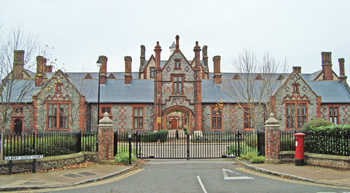
The former workhouse buildings are now Gilbert Scott Court.
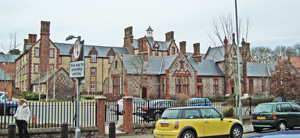
The single-storey administration block is located in front of the 3-storey accommodation block (above and below).
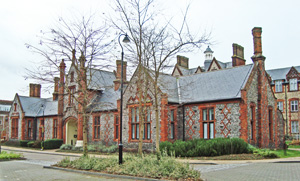
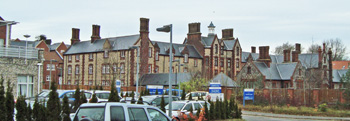
Signage for the new Hospital is seen to the south of the workhouse building.
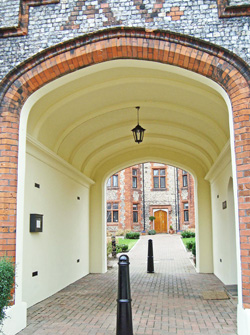
The central archway, once bricked up with only a single door for ingress, has now been opened up. 'AV' above the arch stands for 'Amersham Union'.
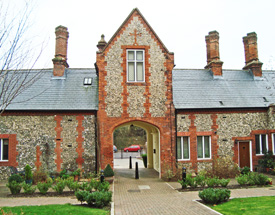
The view on the other side of the archway, looking towards Whielden Road.
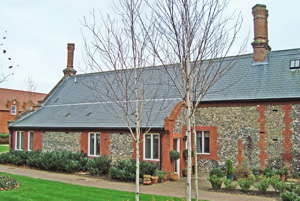
The backs of the wings of the administration building (above and below).
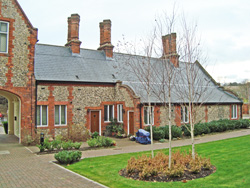
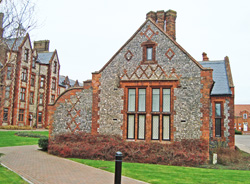
The end of the eastern wing.
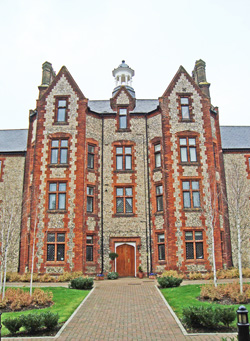
The central section of the workhouse.
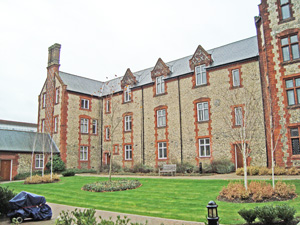
The western (above) and the eastern (below) wings.
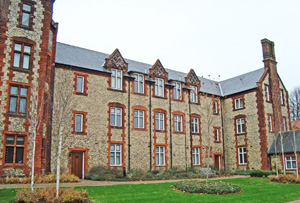
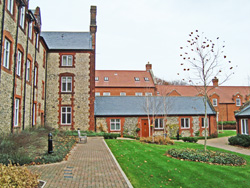
New housing has been built around the old buildings (above and below).
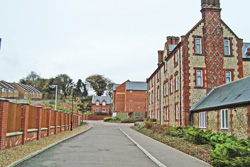
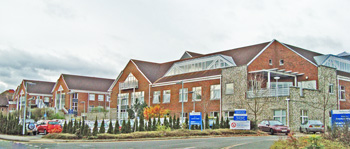
The new Amersham Hospital was built to the south of the former workhouse.

Gilbert Scott Court can be seen in the distance.
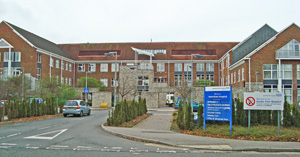
Entrance 2 - the main entrance - to the new Hospital.
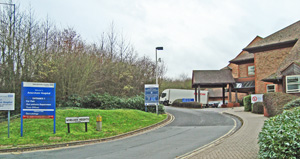
Entrance 1 at the southern side of the Hospital, leading to the Haleacre Unit and the Dermatology Department.
(Author unstated) 1998 Work begins on the £20 million redevelopment of Amersham Hospital. Bucks Free Press, 18th July.
(Author unstated) 2001 Duke of Kent does the honours at Amersham Hospital. Bucks Free Press, 23rd February.
(Author unstated) 2004 Haleacre mental health unit could be closed. Bucks Free Press, 6th February.
(Author unstated) 2009 Crunch time at hospital. Get Bucks, 5th November.
Brunett N 2007 Haleacre future in doubt as ward goes. Bucks Free Press, 4th June.
Brunetti N 2007 Longer journeys for mental health patients. Bucks Free Press, 11th June.
Carswell A 2009 Amersham Hospital future to be discussed in Parliament. Bucks Free Press, 10th December.
Collins R 2004 What will new health managers leave us with? Bucks Free Press, 15th June.
Evans O 2001 Key clinics leave Amersham Hospital. Bucks Free Press, 28th June.
Evans O 2008 'Under-used' Amersham Hospital buildings 'should be rented or sold'. Bucks Free Press, 10th April.
Evans O 2009 Clinics and beds closing at Amersham and Marlow hospitals. Bucks Free Press, 25th November.
Dunhill L 2011 Doctor John Wilkinson urges health bosses to save specialist ward. Bucks Free Press, 1st December.
Dunhill L 2011 Patients asked about 'under review' dermatology services. Bucks Free Press, 15th December.
Dunhill L 2012 Overnight beds set to close on specialist ward at Amersham Hospital. Bucks Free Press, 22nd November.
Salmon N 1988 The History of Amersham General Hospital 1838-1988. Amersham, self-published.
Soodin V 2003 Hospital care for elderly on brink as ward for elderly faces closure. This is Wiltshire, 31st October.
http://amershamhistory.info
https://upb.buckscc.gov.uk
www.amersham.org.uk (1)
www.amersham.org.uk (2)
www.amersham.org.uk (3)
www.bad.org.uk
www.bbc.co.uk (1)
www.bbc.co.uk (2)
www.britainfromabove.org.uk
www.buckshealthcare.nhs.uk
www.flickr.com
www.independent.co.uk
www.publications.parliament.uk
www.renalassociation.org
www.szal.co.uk
www.workhouses.org.uk
Return to home page